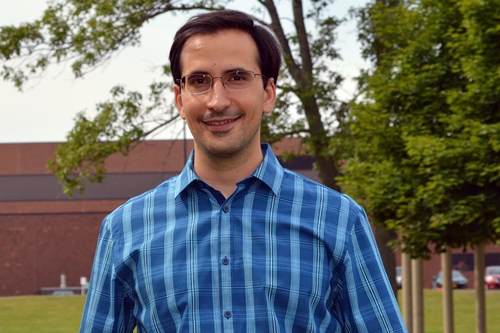28 October 2015. A heart pacemaker — the device regulating heartbeats of people with slow or irregular heart rhythms — is being designed to draw power from the beating heart itself and work with next-generation devices that operate inside the heart without wires or leads. Engineers from University at Buffalo in New York, in the lab led mechanical and aerospace engineering professor Amin Karami, are building a prototype device and expect to conduct tests with animals in about two years.
Karami and colleagues aim to solve a continuing problem with pacemakers, both conventional and leadless, namely the need to replace the devices once the battery runs out, usually in 5 to 12 years. If the battery is in a conventional pacemaker, full-scale invasive surgery is required for a replacement. Smaller and self-contained leadless pacemakers, now in clinical trials, are inserted and removed with a catheter through the femoral vein starting in the thigh.
The solution being developed in Karami’s lab is to capture the vibrations of a beating heart, even one with an irregular heartbeat, as the power source for the device. These piezoelectric systems, as they’re called, use materials that respond to the vibrations of the heart and convert those vibrations into the low level of electric power needed to power the device.
As a research fellow at University of Michigan in 2012, as reported in Science & Enterprise, Karami built a proof-of-concept piezoelectric system designed to power a conventional pacemaker. That system uses ceramic materials built on a brass substrate that responds to vibrations in the chest cavity caused by heartbeats. The system adds tiny magnets to enhance power production and make the energy harvesting mechanism less sensitive to heart rate changes. This non-linear function, as it’s called, is important with fluctuating heart rates, the very condition pacemakers are called up on to correct.
The Buffalo researchers are now adapting that concept to the smaller, leadless pacemakers designed to work inside the heart, for people needing to stimulate one chamber of the heart, a condition affecting 20 to 30 percent of patients requiring pacemakers. Leadless pacemakers are about 1/10th the size conventional pacemakers, but Karami says the battery takes up about 60 percent of that device. As reported in Science & Enterprise in August 2015, first findings from clinical trials of leadless pacemakers show the devices maintain effective pacing of patients’ hearts and work without serious adverse effects in a vast majority of cases.
Buffalo is a pioneer in the development of heart pacemakers. The first successful pacemaker implantation took place in Buffalo in 1960, with the patient surviving another 18 months. That surgery used a device made by Wilson Greatbatch, an engineer trained at University of Buffalo, as it was known at the time. He went on the found the company Wilson Greatbatch Ltd. in nearby Clarence, New York, which became a leading producer and innovator in power supplies for medical devices. After a series of acquisitions, the company Greatbatch Inc. moved its headquarters to Texas.
Karami tells more about the device in the following video.
- Self-Propelled Particles Designed to Stop Bleeding
- Hydrogel Aids Stem Cells Repair Heart Functions
- Technique Devised to Deliver Small Drug Amounts to Lungs
- In-Heart Pacemaker Benefits Shown in Clinical Trial
- Simple Scaffold Developed for Synthetic Heart Tissue
Disclosure: The author has a pacemaker.
* * *


 RSS - Posts
RSS - Posts
[…] Heart-Powered Leadless Pacemaker in Development […]
[…] Heart-Powered Leadless Pacemaker in Development […]